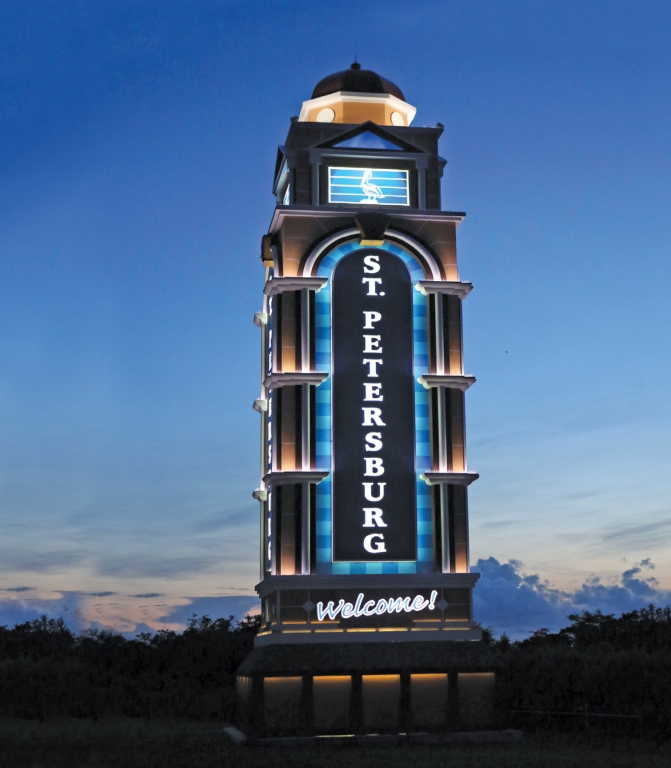Florida depends on your tourism dollars to fuel its economy, and signs play a key role in creating a welcoming atmosphere. The Bill Edwards Group, a St. Petersburg, FL real-estate developer, hired Thomas Sign & Awning Co. Inc. (Clearwater, FL) to fabricate a 75-ft.-tall entry sign to warmly welcome visitors to Florida’s “Sunshine City.”
Bar-Fab of Florida and United Steel Works constructed the support structure with 3,000 linear ft. of structural steel, and Hennessey Construction built the sign’s foundation using Geo Tech boring drills and heavy-duty auger-drilling and concrete-pumping equipment.
Eighteen, 2-ft.-diameter, 35-40-ft.-deep caisson columns with rebar reinforcements bolster the structure for volatile coastal weather. According to Thomas Sign & Awnings’ Kevin Hunsicker, the sign is rated for a 150-mph wind load – a necessity in hurricane-prone, coastal areas. More than 35,000 sq. ft. of sod was required to fill in the huge foundation. The job entailed MIG-welding the main tower structure and its bracing reinforcements.
Glen Welden, Thomas Sign & Awning’s director of design, developed the artwork and copy with Adobe Illustrator software, and devised the structure using SAP 3000 engineering and AutoCAD drafting software. Led by production manager Todd Thomas, the shop fabricated the sign’s exterior, aluminum elements on its MultiCam 3000 CNC router, and built the vertical text on three sides with routed-out, 0.090-in.-thick, aluminum panels. Second-surface, push-through letters are decorated with plotter-cut, translucent3M vinyl. A synthetic stucco finish was then applied to the tower for an additional textured layer.
The sign features a Fulham induction-lighting system, which was chosen for its low-power consumption, ability to light more quickly with less warm-up time than HID systems, and brighter, more consistently luminescent white coloration. A draw of 40 amps at 277V powers the entire sign. The power source was pulled from more than 1,500 linear ft. away, and had to be bored under the interstate to deliver it to the location. Four, multi-fixture LEDs highlight the tower’s dome.
Hunsicker said the foundation, engineering and DOT-permitting process proved challenging; multiple DOT agencies had to be contacted for authorization. An electric tower being installed only 100 ft. from the water’s edge is bound to require stringent approval. And, ironically, a skyscraping tower encountered a low-lying nemesis.
Advertisement
“The area where we installed the tower is infested with rattlesnakes,” Hunsicker said. “We inspected the job site closely every morning to make sure we had no unwanted visitors.”



 Tip Sheet4 days ago
Tip Sheet4 days ago
 Business Management2 weeks ago
Business Management2 weeks ago
 Real Deal5 days ago
Real Deal5 days ago
 Women in Signs2 weeks ago
Women in Signs2 weeks ago
 Benchmarks2 days ago
Benchmarks2 days ago
 Editor's Note1 week ago
Editor's Note1 week ago
 Women in Signs5 days ago
Women in Signs5 days ago
 Line Time2 weeks ago
Line Time2 weeks ago









